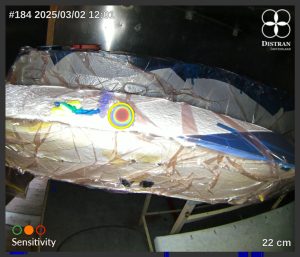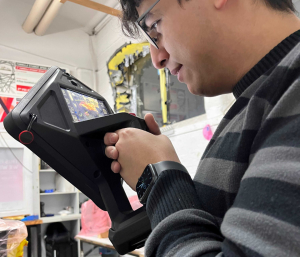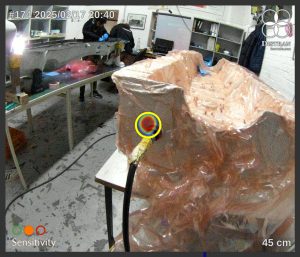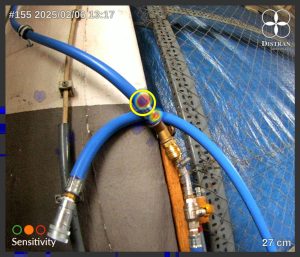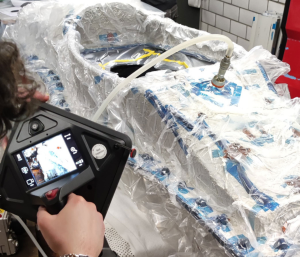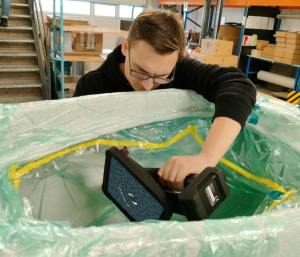20 Nov How Formula Student teams perfect carbon-fiber racing car parts with Distran acoustic cameras
Composites meet acoustic imaging: redefining precision in manufacturing
How Formula Student teams perfect carbon-fiber racing car parts with Distran acoustic cameras
In the world of composite manufacturing, precision is everything. From lightweight aerospace parts to carbon-fiber monocoques for racing cars, even the tiniest air leak can compromise parts’ quality.
That’s where Distran’s ultrasonic acoustic cameras come into play. By visualizing ultrasound emitted by leaks on vacuum bags, they enable engineers to detect leaks that are otherwise invisible and often inaudible, before treatment. Excelling at finding leaks, even in noisy composite manufacturing halls, this means faster leak checks, more reliable production process, and less waste.
Over the last season, two Formula Student Teams — Team Karlsruhe and Team Weingarten — adopted Distran’s technology to optimize their Carbon-Fiber Reinforced Plastic (CFRP) production. Both teams deployed Ultra CE ultrasound camera for their monocoque and other composite parts, and the results speak for themselves.
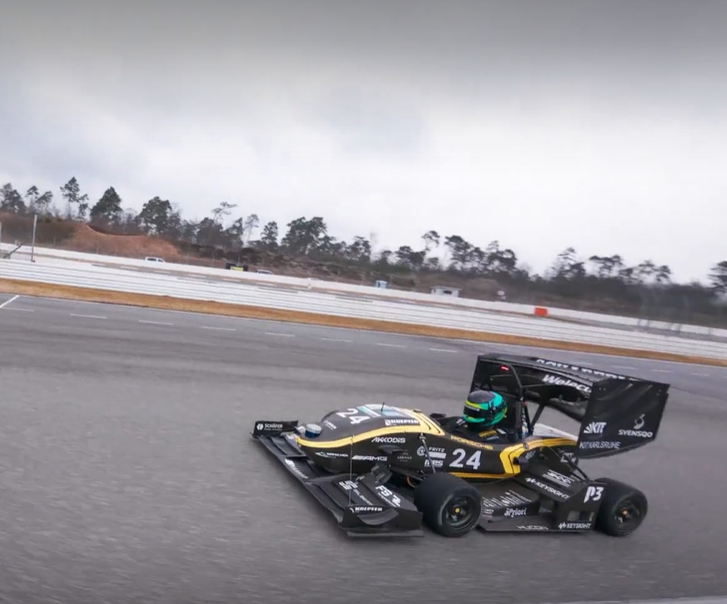
Composites meet acoustic imaging: redefining precision in manufacturing
How Formula Student teams perfect carbon-fiber racing car parts with Distran acoustic cameras

In the world of composite manufacturing, precision is everything. From lightweight aerospace parts to carbon-fiber monocoques for racing cars, even the tiniest air leak can compromise parts’ quality.
That’s where Distran’s ultrasonic acoustic cameras come into play. By visualizing ultrasound emitted by leaks on vacuum bags, they enable engineers to detect leaks that are otherwise invisible and often inaudible, before treatment. Excelling at finding leaks, even in noisy composite manufacturing halls, this means faster leak checks, more reliable production process, and less waste.
Over the last season, two Formula Student Teams — Team Karlsruhe and Team Weingarten — adopted Distran’s technology to optimize their Carbon-Fiber Reinforced Plastic (CFRP) production. Both teams deployed Ultra CE ultrasound camera for their monocoque and other composite parts, and the results speak for themselves.
The project
The Formula Student Project is one of the world’s leading engineering competitions, where more than 800 university teams design, build, and race their own combustion, electric, or driverless cars. Born in 1981 as a combustion-only event in the United States, it has grown into a global platform that reflects the future of mobility. Teams enjoy broad freedom in their designs, with regulations focusing mainly on safety. And unlike traditional racing, the fastest car alone doesn’t win; teams are judged across eight dynamic and static events, from on-track performance to design and cost evaluations, which are reviewed by experts from the motorsport and industry sectors.
The project
The Formula Student Project is one of the world’s leading engineering competitions, where more than 800 university teams design, build, and race their own combustion, electric, or driverless cars. Born in 1981 as a combustion-only event in the United States, it has grown into a global platform that reflects the future of mobility. Teams enjoy broad freedom in their designs, with regulations focusing mainly on safety. And unlike traditional racing, the fastest car alone doesn’t win; teams are judged across eight dynamic and static events, from on-track performance to design and cost evaluations, which are reviewed by experts from the motorsport and industry sectors.
Two stories, one goal: race-ready vacuum bags
Team Karlsruhe
The Karlsruhe team used Distran’s camera to inspect around 20 carbon-fiber parts, from smaller composite components (down to 14 cm radius × 20 cm height) to a 2-meter monocoque (2.25 × 0.625 × 0.635 m).
Before, leak detection relied on listening for faint hissing—sometimes with a stethoscope—while pulling 1 bar delta pressure to check vacuum integrity. It was a slow and frustrating process, especially late at night before a curing cycle.
With Distran’s acoustic camera, the team could instantly visualize leaks on the display, so different operators could pinpoint and seal them quickly. The new process saved about 10 minutes per part and reduced bag ruptures during autoclave curing, speeding up production and part quality.
“We realised our own hearing wasn’t comparable to what the Ultra CE could detect.
I was very impressed by how much time and stress it saved us.
The vacuum-bagging process wasn’t only faster; it was intuitive and efficient instead of frustrating.”
Mathilda Storath, Monocoque Subteam Lead

Two stories, one goal: race-ready vacuum bags
Team Karlsruhe
The Karlsruhe team used Distran’s camera to inspect around 20 carbon-fiber parts, from smaller composite components (down to 14 cm radius × 20 cm height) to a 2-meter monocoque (2.25 × 0.625 × 0.635 m).
Before, leak detection relied on listening for faint hissing—sometimes with a stethoscope—while pulling 1 bar delta pressure to check vacuum integrity. It was a slow and frustrating process, especially late at night before a curing cycle.
With Distran’s acoustic camera, the team could instantly visualize leaks on the display, so different operators could pinpoint and seal them quickly. The new process saved about 10 minutes per part and reduced bag ruptures during autoclave curing, speeding up production and part quality.
“We realised our own hearing wasn’t comparable to what the Ultra CE could detect.
I was very impressed by how much time and stress it saved us.
The vacuum-bagging process wasn’t only faster; it was intuitive and efficient instead of frustrating.”
Mathilda Storath, Monocoque Subteam Lead

Team Weingarten
Team Weingarten manufactured many CFRP parts in-house—from smaller components, such as 0.5-meter aerowings, to a 2.5-meter monocoque body with complex geometry that required checking two vacuum sides. For pre-cure checks, they pulled a delta pressure of 0.9 bar; rims and monocoque are then autoclave-cured at 3 to 7 bar, while other parts are vacuum-cured in an oven.
Before being equipped with Distran’s Ultra CE camera, leak search involved listening for faint leaks through human hearing and manually manipulating the vacuum bag folds to localize them, and then only patching holes or bag defects with tacky tape ; a slow and imprecise process.
With Distran’s ultrasonic acoustic camera, the team could inspect all parts and vacuum bags, locate and seal leak points immediately. The result was direct: bags were tight and didn’t burst in the autoclave. This led to a more repeatable approach to leak inspection and better part quality, reducing waste.
The team found Ultra CE intuitive to use, providing instant results displayed on the screen. In their process, this brought better vacuum integrity, fewer failures in the autoclave, and repeatable part quality.
“The Distran camera is astonishingly effective — you achieve great results with almost no effort.
It’s so intuitive to use that I wouldn’t go anywhere without it!”
Team Weingarten
Team Weingarten manufactured many CFRP parts in-house—from smaller components, such as 0.5-meter aerowings, to a 2.5-meter monocoque body with complex geometry that required checking two vacuum sides. For pre-cure checks, they pulled a delta pressure of 0.9 bar; rims and monocoque are then autoclave-cured at 3 to 7 bar, while other parts are vacuum-cured in an oven.
Before being equipped with Distran’s Ultra CE camera, leak search involved listening for faint leaks through human hearing and manually manipulating the vacuum bag folds to localize them, and then only patching holes or bag defects with tacky tape ; a slow and imprecise process.
With Distran’s ultrasonic acoustic camera, the team could inspect all parts and vacuum bags, locate and seal leak points immediately. The result was direct: bags were tight and didn’t burst in the autoclave. This led to a more repeatable approach to leak inspection and better part quality, reducing waste.
The team found Ultra CE intuitive to use, providing instant results displayed on the screen. In their process, this brought better vacuum integrity, fewer failures in the autoclave, and repeatable part quality.
“The Distran camera is astonishingly effective — you achieve great results with almost no effort.
It’s so intuitive to use that I wouldn’t go anywhere without it!”
Reliable, high-quality composite parts
for performance that allows no compromise
For both teams, Distran’s Ultra CE acoustic camera became an indispensable tool in their composite manufacturing workflow.
By pinpointing leaks before treatment, they saved valuable time, avoided re-laying entire vacuum bags, ensured flawless curing cycles and reduced wasted material and parts. Distran’s technology provided a level of confidence and reliability that traditional methods couldn’t deliver.
What was a demanding student project has proven how Distran Ultra CE supports quicker, consistent and high composite parts quality.
Learn more about KA-RaceIng’s Formula Student team and the Weingarten Formula Student team and their journey toward race-ready performance.
Reliable, high-quality composite parts for performance that allows no compromise
For both teams, Distran’s Ultra CE acoustic camera became an indispensable tool in their composite manufacturing workflow.
By pinpointing leaks before treatment, they saved valuable time, avoided re-laying entire vacuum bags, ensured flawless curing cycles and reduced wasted material and parts. Distran’s technology provided a level of confidence and reliability that traditional methods couldn’t deliver.
What was a demanding student project has proven how Distran Ultra CE supports quicker, consistent and high composite parts quality.
Learn more about KA-RaceIng’s Formula Student team and the Weingarten Formula Student team and their journey toward race-ready performance.

